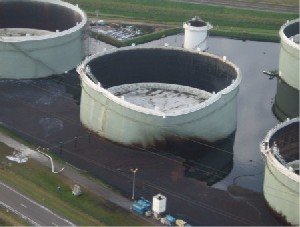In a storage area of a refinery, a tank buckled at 6:35 pm, causing 37,000 m³ of crude oil to pour out like a wave. In less than 15 min, the site’s 4-hectare retention basin was covered 1 m deep in oil and 3 m3 of petroleum spilled over the several meter-high dike walls polluting the polder ditch situated at the outside of the oil terminal.
Local authorities activated the disaster plan. Both internal and external response teams sought to cover the retention basin with foam (214 tons of foam supplied by the refinery, local firefighting crews, civil protection agencies and contracted firms). The vast extent of the area to be covered, coupled with high winds (which fortunately helped limit the risk of explosion), rendered the operation fruitless. The oil present in the depot’s other tanks was channelled to the refinery and basin contents were transferred within 2 days into 3 onsite reservoirs using the wastewater pumping station.
Local residents were asked to close their doors and windows due to the pungent odours. Those were attenuated on the next day due to the deposit of a sand layer inside the retention basin. The damaged tank drifted to one side and its foundations partially shifted : 4 cranes were used to support and stabilize it.
A ditch had formed at the tank bottom 1.5 m from the sidewall, locally preventing water from circulating through the drains and thereby creating considerable internal corrosion over a portion of the bottom metal plates (35 cm x 20 cm), thinning the plates down at their extremities. On October 25, a small leak, which first remained confined in rough areas of the stone foundation ring, had apparently saturated the compacted sand below the tank with oil. Since the foundations had been locally weakened by this fluidised bed under the oil pressure, the bottom of the tank split open along the ditch width.
The inspection revealed that all depot tanks contained a ditch and internal corrosion. The ruptured reservoir was dismantled, while the others were repaired and their stability verified prior to being placed back in service. The depot operator then covered all tank bottoms with a layer of protective lining to prevent against corrosion and analysed the aggressive composition of decanted water in the crude oil tanks. The operator strengthened its control procedures by implementing measurements by means of acoustic emissions between each internal inspections of the reservoirs with a scan of the tank bottom thickness over the entire surface should the slightest doubt arises. The tanks will be equipped with levels alarms to detect leaks and a study is conducted to evaluate the feasibility of an on-line oil detection system under the storage tanks.
Download the detailed report in .pdf format (560 Kb)





